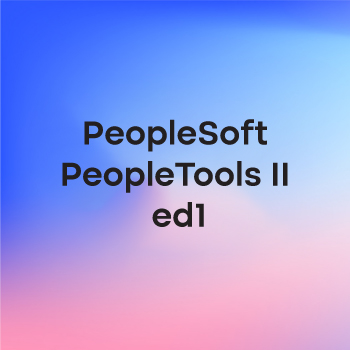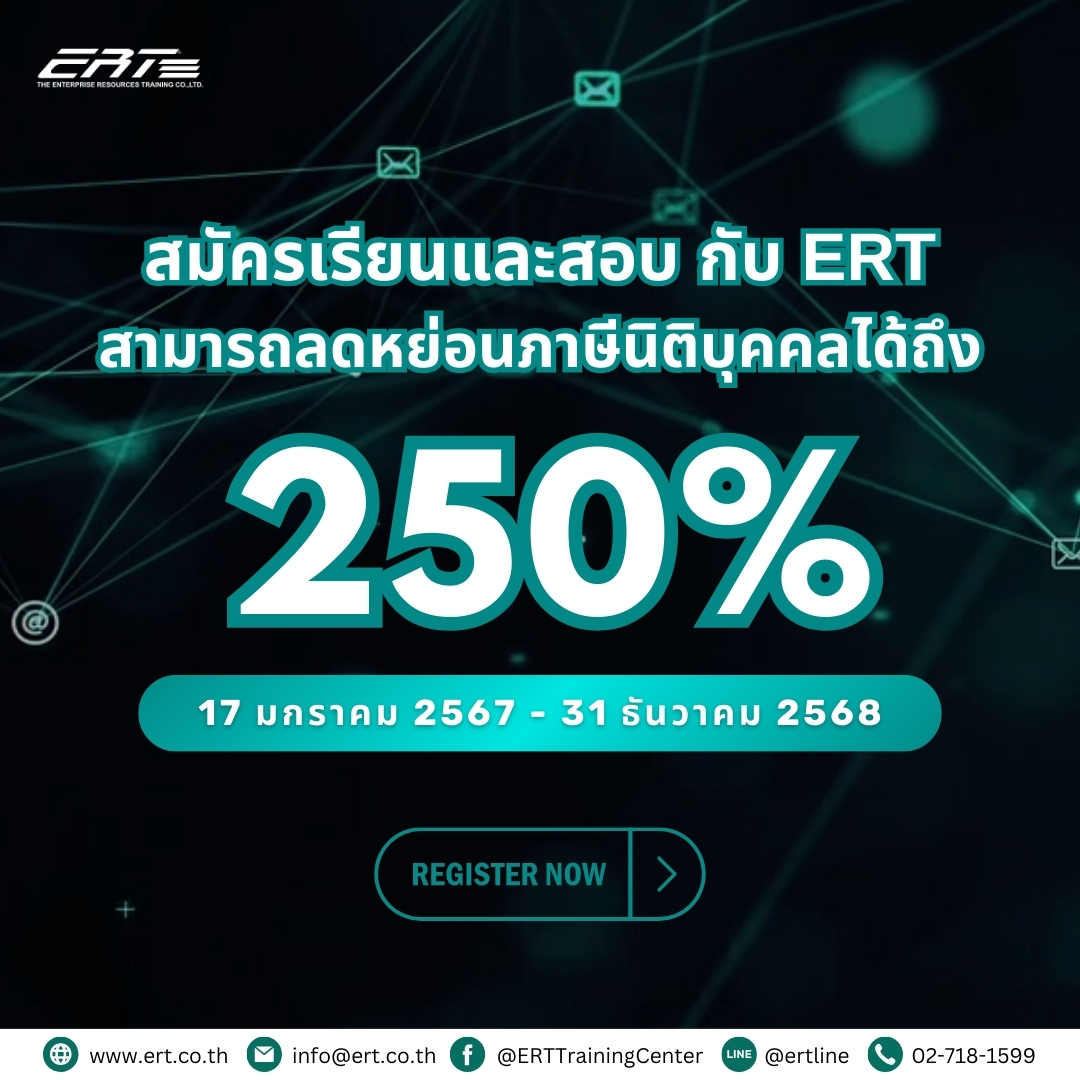PeopleSoft PeopleTools II ed1
This PeopleTools II training helps you develop and configure more advanced PeopleSoft applications. Learn to create applications that incorporate parent-child data structures, views, multiple occurs levels, subrecords, subpages, tableset sharing, and selected fluid user interface features.
STUDENTS WILL LEARN TO
- Apply PeopleSoft design methodology in developing both classic and fluid applications.
- Create and use views as the basis for summary pages, search records, and prompt tables.
- Explain and implement TableSet sharing.
- Create records and pages that maintain parent-child relationships.
- Explain the buffer allocation process and its impact on application performance.
- Create and use subrecords and subpages in an application.
- Build components that demonstrate the benefits and detractors of deferred processing mode.
- Write PeopleCode programs to satisfy business requirements and enhance applications.
- Enhance application and page functionality using advanced PeopleTools features, such as: images, links, styles, and deferred processing.
- Troubleshoot common problems in PeopleSoft applications.

|
Phone
|
Phone
|
|---|---|
|
Product
|
Oracle
|
|
Code
|
D105605GC10
|
|
Duration
|
5 Days
|
|
Price (baht)
|
70,500
|
About the course
COURSE TOPICS
Module 1 : PeopleTools II Course Overview
- Course Overview
Module 2 : PeopleTools II Technology Overview
- Technology Overview
- Describing the Difference Between Development and Test Environments (continued)
Module 3 : Developing Applications with PeopleTools
- Developing Applications with PeopleTools
- Creating Data Structures
- Creating User Interfaces
- Testing Applications
- Creating Fluid Applications
- Review
- Activity 1: Designing an Application
- Activity 2: Creating Data Structures
- Activity 3: Creating User Interfaces
- Activity 4: Testing the Application
- Activity 5: Creating a Fluid Application
Module 4 : Using Views in PeopleSoft Applications
- Using Views in PeopleSoft Applications
- Creating PeopleSoft SQL Views
- Creating PeopleSoft Query Views
- Creating PeopleSoft Dynamic Views
- Activity 6: Writing SQL Statements
- Activity 7: Creating PeopleSoft SQL Views
- Activity 8: Creating PeopleSoft Query Views
Module 5 : Creating Summary Pages Using Views
- Creating Summary Pages Using Views
- Determining the Key Structure for a Summary View
- Creating Summary Pages Using Views (Review )
- Activity 9: Creating a Summary Application
- Activity 10: Using Views in Summary Applications
Module 6 : Creating and Using Search Records
- Creating and Using Search Records
- Using Views to Provide Additional Search Criteria
- Using Views to Provide Additional Search Criteria (continued)
- Activity 11: Modifying a Search Record
- Activity 12: Using a Search View
- Activity 13: Implementing the Add Search Record
- Activity 14: Creating an Application
Module 7 : Implementing Search Pages for Fluid Applications
- Implementing Search Pages for Fluid Applications
- Describing How the PeopleSoft Fluid User Interface Uses Search Pages (continued)
- Incorporating a Search Framework-based Keyword Search into Fluid Applications (continued)
- Incorporating Pivot Grid-based Real-Time Search into Fluid Applications
- Activity 15: Working with Keyword Search
- Activity 16: Implementing Real-Time Component Search for a Fluid Application
Module 8 : Using Views as Prompt Table Edits
- Using Views as Prompt Table Edits
- Explaining the Mechanics of Prompting
- Activity 17: Creating a Prompt Table View
- Activity 18: Examining Prompt Table Functionality
- Activity 19: Enhancing the Student Suggestions Application
Module 9 : Explaining TableSet Sharing
- Explaining TableSet Sharing
- Explaining the Technical Aspects of TableSet Sharing
- Explaining the Technical Aspects of TableSet Sharing (continued)
- Implementing TableSet Sharing
- Activity 20: Observing TableSet Sharing
- Activity 21: Implementing TableSet Sharing for the Maintain Purchase Orders Application
- Activity 22: Using TableSet Sharing
Module 10 : Creating Parent-Child Relationships
- Creating Parent-Child Relationships
- Enforcing Parent-Child Relationships on Page Definitions
- Activity 23: Creating Parent-Child Records in PeopleSoft Applications
- Activity 24: Creating Parent-Child Pages in PeopleSoft Applications
- Activity 25: Creating Parent-Child Relationships
Module 11 : Explaining Buffer Allocation
- Explaining Buffer Allocation
- Determining the Effect of Buffer Allocation on Performance
Module 12 : Creating Subrecords and Subpages
- Creating Subrecords and Subpages
- Stating the Purpose of Subpages
- Activity 26: Creating and Using Subrecords
- Activity 27: Creating and Using Subpages
Module 13 : Using Deferred Processing
- Using Deferred Processing
- Activity 28: Working with Processing Modes
Module 14 : Introducing PeopleCode in PeopleSoft Applications
- Introducing PeopleCode in PeopleSoft Applications
- Accessing PeopleCode Programs
- Exploring Selected PeopleCode Subjects
- Adding Comments to PeopleCode Programs
- Creating Error Messages Using the Message Catalog
- Performing Validations with PeopleCode
- Describing RowInit and FieldChange PeopleCode
- Activity 29: Observing PeopleCode in Action
- Activity 30: Examining PeopleCode Locations
- Activity 31: Writing PeopleCode Error and Warning Programs
- Activity 32: Using Comments in PeopleCode Programs
- Activity 33: Using the Message Catalog
- Activity 34: Writing PeopleCode Programs to Perform Validations
- Activity 35: Observing the Behavior of RowInit and FieldChange PeopleCode
Module 15 : Using Images in PeopleSoft Applications
- Using Images in PeopleSoft Applications
- Working with Images as Application Data
- Activity 36: Working with Static Images
- Activity 37: Working with Images as Application Data
Module 16 : Creating and Using Style Sheets in Classic Applications
- Creating and Using Style Sheets in Classic Applications
- Overriding the System Style Sheet
- Activity 38: Working with Style Sheet Elements
- Activity 39: Using Styles in a Classic Application
Module 17 : Designing More Advanced Pages
- Designing More Advanced Pages
- Creating Pages with Alternate Data Displays
- Creating Links to Internal and External Pages
- Creating Pop-up Pages
- Review
- Activity 40: Using the Message Catalog in Page Design
- Activity 41: Creating Alternate Data Displays
- Activity 42: Creating Links in a PeopleSoft Application
- Activity 43: Creating a Pop-up Page
Module 18 : Final Course Activities
- Final Course Activities
- Activity 44: Troubleshooting Complex Applications
- Activity 45: Creating a Complex Application (Part 01)
- Activity 45: Creating a Complex Application (Part 02)
Module 19 : PeopleTools II Course Review
- Course Review
Register for Training
Schedule
| Start Date | End Date | Duration (days) | Price | Register | Course | Code | Product |
|---|

